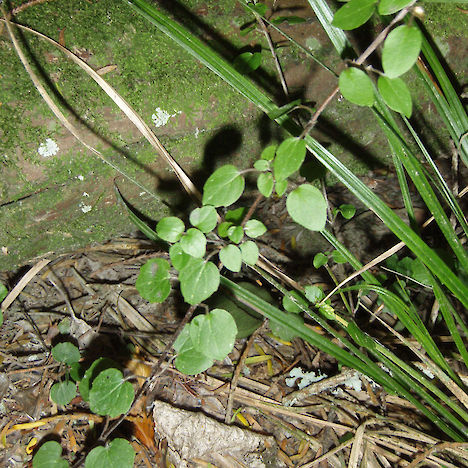Threat category:
Threatened: Nationally Critical?Regions:
Nelson-Tasman, MarlboroughDistribution:
Nelson
Key Features
- A creeping, mint-like herb up to 30 cm tall, softly woody with stems that root at the base. Branches are upright with angular stems that may be covered with fine, soft hairs. Leaves are borne in pairs, widely spaced along the stem, up to 1 cm long and are rounded with broad lobes. They are dotted with small glands (visible when held to light) and may be purplish underneath. Small white helmet-like flowers are held above the foliage, and become pods that open out into a distinctive shovel shape.
Distribution and Habitat
- Restricted to the Nelson region in the South Island. Occurs on free-draining sites in valley floor matai, totara and black beech forest, and in manuka scrub, on river banks and cliffs.
Threats
- Habitat modification and loss.
- Competition with invasive weeds.
- Pig rooting.
- Trampling by stock.
Management Opportunities
- Survey for new locations.
- Mark known sites.
- Protection of habitat.
- Weed control.
- Control of stock and animal pests.
- Re-establishment at appropriate sites within plantation forests.
Monitoring Options
- Check existing populations annually.
- Report new locations to DOC, NZPCN.
Further Information and Support
- New Zealand Plant Conservation Network (NZPCN). http://www.nzpcn.org.nz
- Weed and pest management - Department of Conservation, Regional Councils.
- References:
- Dopson, S.R.; de Lange, P.J.; Ogle, C.C.; Rance, B.D.; Courtney, S. & Molloy, J. (1999). The conservation requirements of New Zealand’s nationally threatened vascular plants. Threatened Species Occasional Publication 13. Department of Conservation, Wellington.
- Wilson, C.M. & Given, D.R. (1989). Threatened plants of New Zealand. DSIR Publishing, Wellington.
- Peter de Lange, Peter Heenan, David Norton, Jeremy Rolfe and John Sawyer (2010). Threatened Plants of New Zealand. Canterbury University Press, Christchurch. 472 pp.





